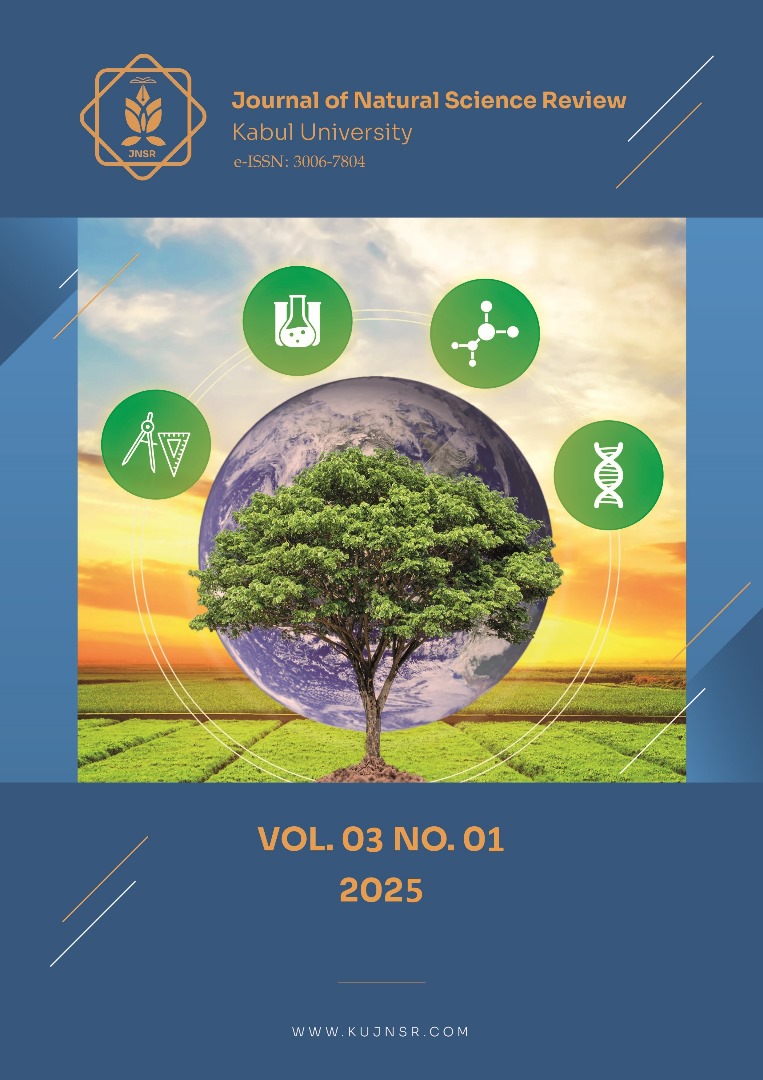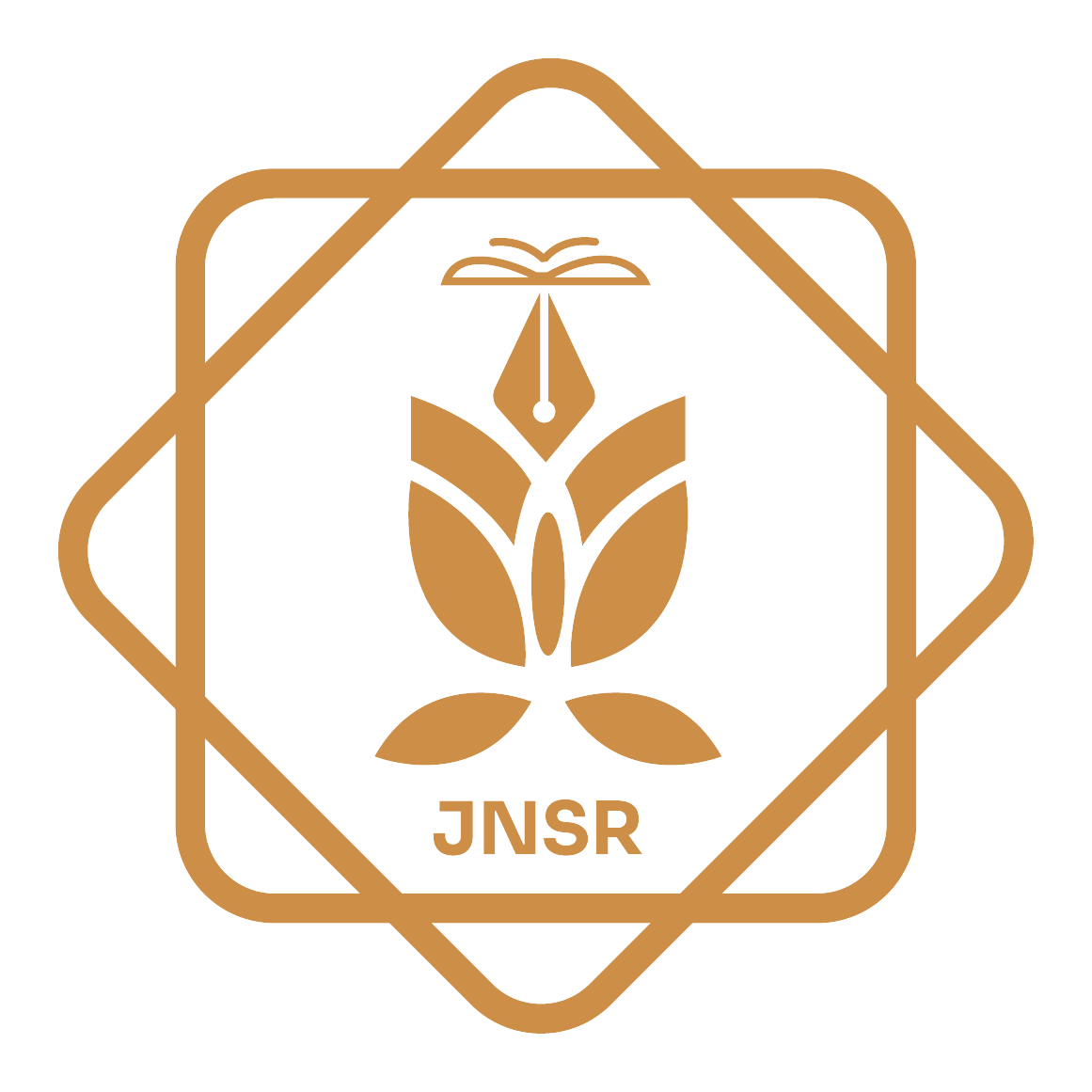Assessment of Groundwater Quality in Kabul City: A Case Study of District 15
DOI:
https://doi.org/10.62810/jnsr.v3i1.173Keywords:
Groundwater, Water Quality, Kabul City, District 15, Chemical ParametersAbstract
In Kabul City, groundwater serves as the primary source of drinking water, but these resources are under immense pressure from both natural and human-induced activities. This study aims to assess the quality of drinking water in District 15 of Kabul city through the analysis of 14 groundwater samples, examining physical (electric conductivity, total dissolved solids, turbidity, and temperature), chemical (pH, chloride, fluoride, nitrate, nitrite, phosphate, boron, copper, cadmium, lead, manganese, and aluminum), and biological (total and fecal coliform) parameters using the standard method. Findings reveal that several sites exhibit exceedances in key parameters such as electric conductivity, total dissolved solids, chloride, fluoride, nitrate, boron, cadmium, and coliforms exceeding the WHO and ANSA permissible limits, posing significant health risks. To supply safe drinking water for Kabul city residents, it is recommended that future research should assess the groundwater quality across the 22 districts of Kabul city, factoring in seasonal variations over a year.
Downloads
References
Afghan, F.R., Habib, H., Akhunzada, N.A. et al. Customization of GIS for spatial and temporal analyses of Air Quality Index trends in Kabul city. Model. Earth Syst. Environ. 8, 5097– 5106 (2022). https://doi.org/10.1007/s40808-022-01396-5 DOI: https://doi.org/10.1007/s40808-022-01396-5
Ahmadi, S. A., Sakha, M. Z., & Rahimi, M.(2024). Bacteriological Evaluation of Drinking Water Quality from Kabul University Taps.Journal of Natural Science Review, 2(3), 47-58. DOI:https://doi.org/10.62810/jnsr.v2i3.45 DOI: https://doi.org/10.62810/jnsr.v2i3.45
Alhumoud, J. M., Al-Ruwaih, F. M., & Al-Dhafeeri, Z. M. (2010). Groundwater quality analysis of limestone aquifer of Al-Sulaibiya field, Kuwait. Desalination, 254(1–3), 58–67. https://doi.org/10.1016/j.desal.2009.12.014 DOI: https://doi.org/10.1016/j.desal.2009.12.014
Ahmed, J., Chua, Y. P., Wong, L. P., & Channa, N. (2020). Drinking Water Quality Mapping Using Water Quality Index and Geospatial Analysis in Primary Schools of Pakistan. Water, 12(12), 3382. https://doi.org/10.3390/w12123382 DOI: https://doi.org/10.3390/w12123382
Akuo-Ko, E. O., Shahrokhi, A., Otoo, F., Kovács, T., Csordás, A., Amponsem, E., Glover, E. T., & Tettey-Larbi, L. (2023). A Comprehensive Radiological Survey of Groundwater Resources in Artisanal Mining Communities in the Eastern Region of Ghana: Water Quality vs. Mining Activities. Water, 16(1), 62. https://doi.org/10.3390/w16010062 DOI: https://doi.org/10.3390/w16010062
Babel, M. S., Rivas, A. A., Gupta, A. D., & Kataoka, Y. (2012). Improving Groundwater Quality Management for the Sustainable Utilization of the Bangkok Aquifer System. International Journal of Water Resources Development, 28(2), 355–371. https://doi.org/10.1080/07900627.2012.668645 DOI: https://doi.org/10.1080/07900627.2012.668645
Bain, R. et al. (2014). Global assessment of exposure to faecal contamination through drinking water based on a systematic review. Tropical Medicine & International Health, 19(8), 917-927. https://doi.org/10.1111/tmi.12334 DOI: https://doi.org/10.1111/tmi.12334
Burke, F., Khan, I., Azam, M., Nawaz-Ul-Huda, S., Naseem, S., & Hamza, S. (2016). Impact of Cadmium Polluted Groundwater on Human Health. Sage Open, 6(1), 215824401663440. https://doi.org/10.1177/2158244016634409 DOI: https://doi.org/10.1177/2158244016634409
Chakraborty, S., Roy, S., Das, B., Mukherjee, A., & Singha, S. K. (2023). Electrical Conductivity as an Indicator of Sea Water Intrusion in South 24 Parganas, West Bengal, India (pp. 67– 76). Springer Nature Singapore. https://doi.org/10.1007/978-981-99-0823-3_7 DOI: https://doi.org/10.1007/978-981-99-0823-3_7
Currell, M. (2014). Mega-scale groundwater quality challenges and the need for an inter- disciplinary approach. Hydrogeology Journal, 22(4), 745–748. https://doi.org/10.1007/s10040-014-1119-z DOI: https://doi.org/10.1007/s10040-014-1119-z
Caravella, K. D., & Martinez, J. D. (2020). Water Quality and Quantity: Globalization. In Managing Water Resources and Hydrological Systems (pp. 265-276). CRC Press. https://doi.org/10.1201/9781003045045-28 DOI: https://doi.org/10.1201/9781003045045-28
Donohue, S., Mccarthy, V., Rafferty, P., Orr, A., & Flynn, R. (2015). Geophysical and hydrogeological characterisation of the impacts of on-site wastewater treatment discharge to groundwater in a poorly productive bedrock aquifer. Science of The Total Environment, 523, 109–119. https://doi.org/10.1016/j.scitotenv.2015.03.117 DOI: https://doi.org/10.1016/j.scitotenv.2015.03.117
Dotsika, E., Michelot, J. L., Kloppmann, W., & Poutoukis, D. (2006). Stable Isotope and Chloride, Boron Study for Tracing Sources of Boron Contamination in Groundwater: Boron Contents in Fresh and Thermal Water in Different Areas in Greece. Water, Air, and Soil Pollution, 174(1–4), 19–32. https://doi.org/10.1007/s11270-005-9015-8 DOI: https://doi.org/10.1007/s11270-005-9015-8
Dutta, V., Fatima, N., & Kumar, N. (2018). Excessive fluoride in groundwater of Central Ganga Alluvial Plain: a case study of Fatehpur, North India. International Journal of Environmental Science and Technology, 16(12), 7791–7798. https://doi.org/10.1007/s13762-018-2145-5 DOI: https://doi.org/10.1007/s13762-018-2145-5
Fewtrell, L. (2004). Drinking-water nitrate, methemoglobinemia, and global burden of disease: a discussion. Environmental Health Perspectives, 112(14), 1371–1374. https://doi.org/10.1289/ehp.7216 DOI: https://doi.org/10.1289/ehp.7216
Gadgil, A., Levine, M., Levi, B., Hafemeister, D., & Schwartz, P. (2008). Safe and Affordable Drinking Water for Developing Countries (Vol. 1044, Issue 1). american institute of physics. https://doi.org/10.1063/1.2993719 DOI: https://doi.org/10.1063/1.2993719
Graham, J. P., & Polizzotto, M. L. (2013). Pit latrines and their impacts on groundwater quality: A systematic review. Environmental International, 47, 87-94. https://doi.org/10.1016/j.envint.2012.11.001 DOI: https://doi.org/10.1016/j.envint.2012.11.001
Hamidi, M. D., Gröcke, D. R., Joshi, S. K., & Greenwell, H. C. (2023). Investigating groundwater recharge using hydrogen and oxygen stable isotopes in Kabul city, a semi-arid region. Journal of Hydrology, 626, 130187. https://doi.org/10.1016/j.jhydrol.2023.130187 DOI: https://doi.org/10.1016/j.jhydrol.2023.130187
Hamidi, M. D., Kissane, S., Bogush, A. A., Karim, A. Q., Sagintayev, J., Towers, S., & Greenwell, H. C. (2023). Spatial estimation of groundwater quality, hydrogeochemical investigation, and health impacts of shallow groundwater in Kabul city, Afghanistan. Sustainable Water Resources Management, 9(1), 20. https://doi.org/10.1007/s40899-022-00808-9 DOI: https://doi.org/10.1007/s40899-022-00808-9
Haldorsen, S., Van der Ploeg, M. J., Cendón, D. I., Chen, J., Jemâa, N. C. B., Gurdak, J. J., ... & Zouari, K. (2016). Groundwater and global palaeoclimate signals (G@ GPS). Episodes Journal of International Geoscience, 39(4), 556-567. https://doi.org/10.18814/epiiugs/2016/v39i4/103888 DOI: https://doi.org/10.18814/epiiugs/2016/v39i4/103888
Hayat, E., Baba, A. Quality of groundwater resources in Afghanistan. Environ Monit Assess 189, 318 (2017). https://doi.org/10.1007/s10661-017-6032-1 DOI: https://doi.org/10.1007/s10661-017-6032-1
Jalali, M. (2010). Nitrate pollution of groundwater in Toyserkan, western Iran. Environmental Earth Sciences, 62(5), 907–913. https://doi.org/10.1007/s12665-010-0576-5 DOI: https://doi.org/10.1007/s12665-010-0576-5
Jasechko, S. (2019). Global isotope Hydrogeology―Review. Reviews of Geophysics, 57(3), 835-965. https://doi.org/10.1029/2018RG000627. DOI: https://doi.org/10.1029/2018RG000627
Jawadi, H. A., Snow, D. D., & Sagin, J. (2020). A Detailed Assessment of Groundwater Quality in the Kabul Basin, Afghanistan, and Suitability for Future Development. Water, 12(10), 2890. https://doi.org/10.3390/w12102890. DOI: https://doi.org/10.3390/w12102890
Karim, A.Q. (2018). Groundwater Quality and Concerns of Kabul River Basin, Afghanistan. In: Mukherjee, A. (eds) Groundwater of South Asia. Springer Hydrogeology. Springer, Singapore. https://doi.org/10.1007/978-981-10-3889-1_12 DOI: https://doi.org/10.1007/978-981-10-3889-1_12
Khalil, M., Ahmed, S., Kumar, M., Khan, M. H., & Joshi, R. K. (2020). A Need for City-Specific Water Policies—A Case Study of Kabul City: Afghanistan. In Smart Cities— Opportunities and Challenges: Select Proceedings of ICSC 2019 (pp. 819-829). Springer Singapore. https://doi.org/10.1007/978-981-15-2545-2_66. DOI: https://doi.org/10.1007/978-981-15-2545-2_66
Huang, T., Hao, Y., Tan, Y., Dai, Q., Chen, W., Cui, K., Luo, J., Zeng, H., Shu, W., & Huang, Y. (2024). Low-Mineral Water Diminishes the Bone Benefits of Boron. Nutrients, 16(17), 2881. https://doi.org/10.3390/nu16172881 DOI: https://doi.org/10.3390/nu16172881
Kroehler, C.J. (2014). Potable Water Quality Standards and Regulations: A Historical and World Overview. In: Younos, T., Grady, C. (eds) Potable Water. The Handbook of Environmental Chemistry, vol 30. Springer, Cham. https://doi.org/10.1007/978-3-319- 06563-2_1 DOI: https://doi.org/10.1007/978-3-319-06563-2_1
Kumari, P., Gupta, N. C., & Kaur, A. (2017). A Review of Groundwater Pollution Potential Threats from Municipal Solid Waste Landfill Sites: Assessing the Impact on Human Health. Avicenna Journal of Environmental Health Engineering, 4(1), 11525. https://doi.org/10.5812/ajehe.11525 DOI: https://doi.org/10.5812/ajehe.11525
Luczaj, J., & Masarik, K. (2015). Groundwater Quantity and Quality Issues in a Water-Rich Region: Examples from Wisconsin, USA. Resources (Basel, Switzerland), 4(2), 323–357. https://doi.org/10.3390/resources4020323 DOI: https://doi.org/10.3390/resources4020323
Licciardello, F., Antoci, M. L., Brugaletta, L., & Cirelli, G. L. (2011). Evaluation of groundwater contamination in a coastal area of south-eastern Sicily. Journal of Environmental Science and Health, Part B, 46(6), 498–508. https://doi.org/10.1080/03601234.2011.583870
Mujeeb, M., Ahmadzai, M. R., & Mushwani, H. (2024).The Role of Logar River in Sustaining Agricultural Production: A Case Study.Journal of Natural Science Review, 2(3), 59-68. DOI:https://doi.org/10.62810/jnsr.v2i3.78 DOI: https://doi.org/10.62810/jnsr.v2i3.78
Mukherjee, I., & Singh, U. K. (2018). Groundwater fluoride contamination, probable release, and containment mechanisms: a review on the Indian context. Environmental Geochemistry and Health, 40(6), 2259–2301. https://doi.org/10.1007/s10653-018- 0096-x DOI: https://doi.org/10.1007/s10653-018-0096-x
Mumtaz, M., Ismail, S., Khan, S., Hussain, W., Khan, F. A., & Jahanzaib, S. H. (2024). Implementation Of Water Quality Index For Measuring Groundwater Quality. Migration Letters, 21(S11), 273–287. https://doi.org/10.59670/ml.v21is11.10691 DOI: https://doi.org/10.59670/ml.v21iS11.10691
Mushwani, H., Ahmadzai, M. R., Ullah, H., Baheer, M. S., & Peroz, S. (2024). A comprehensive AHP numerical module for assessing resilience of Kabul City to flood hazards. Urban Climate, 55, 101939.https://doi.org/10.1016/j.uclim.2024.101939 DOI: https://doi.org/10.1016/j.uclim.2024.101939
Nath, K. J. (2018). Arsenic and Fluoride Contamination in Groundwater: Mitigation Strategies (pp. 267–278). Springer Singapore. https://doi.org/10.1007/978-981-13- 1771-2_15 DOI: https://doi.org/10.1007/978-981-13-1771-2_15
Nizam, S., Virk, H. S., & Sen, I. S. (2022). High levels of fluoride in groundwater from the Northern parts of the Indo-Gangetic plains reveal detrimental fluorosis health risks. Environmental Advances, 8,100200. https://doi.org/10.1016/j.envadv.2022.100200 DOI: https://doi.org/10.1016/j.envadv.2022.100200
Noori, A.R., Singh, S.K. Status of groundwater resource potential and its quality at Kabul,
Afghanistan: a review. Environ Earth Sci 80, 654 (2021). https://doi.org/10.1007/s12665-021-09954-3 DOI: https://doi.org/10.1007/s12665-021-09954-3
Okafor, C. O., Ude, U. I., Okoh, F. N., & Eromonsele, B. O. (2024). Safe Drinking Water: The Need and Challenges in Developing Countries. In Water Quality-New Perspectives. IntechOpen. https://doi.org/10.5772/intechopen.108497 DOI: https://doi.org/10.5772/intechopen.108497
Okoro, B. C., Uzoukwu, R. A., & Ademe, C. K. (2016). Quality assessment of groundwater sources of potable water in Owerri, Imo state, Nigeria. Open Access Library Journal, 3(3), 1-6. https://doi.org/10.4236/oalib.1102445 DOI: https://doi.org/10.4236/oalib.1102445
Omonona, O. V., & Okogbue, C. O. (2021). Hydrochemical evolution, geospatial groundwater quality and potential health risks associated with intake of nitrate via drinking water: case of Gboko agricultural district, central Nigeria. Environmental Earth Sciences, 80(4). https://doi.org/10.1007/s12665-021-09448-2 DOI: https://doi.org/10.1007/s12665-021-09448-2
Opie, S., Taylor, R. G., Brierley, C. M., Shamsudduha, M., & Cuthbert, M. O. (2020). Climate– groundwater dynamics inferred from GRACE and the role of hydraulic memory. Earth System Dynamics, 11(3), 775-791. https://doi.org/10.5194/ESD-11-775-2020. DOI: https://doi.org/10.5194/esd-11-775-2020
Panda, B., Dhanu Radha, V., Chidambaram, S., Arindam, M., Thilagavathi, R., Manikandan, S., Thivya, C., Ramanathan, A. L., & Ganesh, N. (2019). Chapter 22 - Fluoride Contamination in Groundwater—A GIS and Geostatistics Reappraisal. In GIS and Geostatistical Techniques for Groundwater Science (pp. 309–322). elsevier. https://doi.org/10.1016/b978-0-12-815413-7.00022-5 DOI: https://doi.org/10.1016/B978-0-12-815413-7.00022-5
Pandey, P. K., Kass, P. H., Soupir, M. L., Biswas, S., & Singh, V. P. (2014). Contamination of water resources by pathogenic bacteria. Environmental Pollution, 185, 8-18. https://doi.org/10.1016/j.envpol.2014.03.050 DOI: https://doi.org/10.1186/s13568-014-0051-x
Pal, M., Panigrahi, S., Hadush, A., Ayele, Y., & Jadhav, V. (2018). Public Health Hazards Due to Unsafe Drinking Water. 7(1), 1–6. https://doi.org/10.4172/2167-7719.1000138
Popa, M., Glevitzky, I. (2021). Groundwater Safety by Monitoring Quality Parameters in Transylvania, Romania. In: Vaseashta, A., Maftei, C. (eds) Water Safety, Security and Sustainability. Advanced Sciences and Technologies for Security Applications. Springer, Cham. https://doi.org/10.1007/978-3-030-76008-3_18 DOI: https://doi.org/10.1007/978-3-030-76008-3_18
Pushpalatha, N., Saravanan, G., Sreeja, V., & Karthik, R. (2022). Total Dissolved Solids and Their Removal Techniques. International Journal of Environmental Sustainability and Protection, 2(2), 13–20. https://doi.org/10.35745/ijesp2022v02.02.0002 DOI: https://doi.org/10.35745/ijesp2022v02.02.0002
Ramalingam, S., Panneerselvam, B., & Kaliappan, S. P. (2022). Effect of high nitrate contamination of groundwater on human health and water quality index in semi-arid region, South India. Arabian Journal of Geosciences, 15(3). https://doi.org/10.1007/s12517-022-09553-x DOI: https://doi.org/10.1007/s12517-022-09553-x
Rawat, R., & Siddiqui, A. R. (2019). Assessment of Physicochemical Characteristics of Drinking Water Quality in Allahabad Metropolitan City, India. The Oriental Anthropologist: A Bi Annual International Journal of the Science of Man, 19(1), 121–135. https://doi.org/10.1177/0972558x19835368 DOI: https://doi.org/10.1177/0972558X19835368
Rehman, H. U., Ahmed, S., & Rahman, M. U. (2023). Depthwise evaluation of total dissolved solids and arsenic from a drilled borehole near River Ravi, Lahore, Pakistan. Journal of Water and Climate Change, 14(11), 4000–4009. https://doi.org/10.2166/wcc.2023.170 DOI: https://doi.org/10.2166/wcc.2023.170
Reshteen, S., Rahmatzai, A., & Safi, A. G. (2024). Urban Water Crisis in Kabul City: Key Challenges and Solutions.Journal of Natural Science Review, 2(3), 138-150. DOI:https://doi.org/10.62810/jnsr.v2i3.51 DOI: https://doi.org/10.62810/jnsr.v2i3.51
Rusydi, A. F. (2018). Correlation between conductivity and total dissolved solid in various types of water: A review. IOP Conference Series: Earth and Environmental Science, 118(1), 012019. https://doi.org/10.1088/1755-1315/118/1/012019 DOI: https://doi.org/10.1088/1755-1315/118/1/012019
Sadler, R., Maetam, B., Edokpolo, B., Connell, D., Yu, J., Stewart, D., Park, M.-J., Gray, D., & Laksono, B. (2016). Health risk assessment for exposure to nitrate in drinking water from village wells in Semarang, Indonesia. Environmental Pollution, 216, 738–745. https://doi.org/10.1016/j.envpol.2016.06.041 DOI: https://doi.org/10.1016/j.envpol.2016.06.041
Siame, T., Kataba, A., M’Kandawire, E., & Muzandu, K. (2023). Comparative determination of human health risks associated with consumption of groundwater contaminated with lead in selected areas surrounding the former lead mine in Kabwe and non-mining areas in Lusaka, Zambia. International Journal Of Community Medicine And Public Health, 10(11), 4089–4095. https://doi.org/10.18203/2394-6040.ijcmph20233434 DOI: https://doi.org/10.18203/2394-6040.ijcmph20233434
Sinha, D., & Prasad, P. (2019). Health effects inflicted by chronic low-level arsenic contamination in groundwater: A global public health challenge. Journal of Applied Toxicology, 40(1), 87–131. https://doi.org/10.1002/jat.3823 DOI: https://doi.org/10.1002/jat.3823
Stevanović, Z. (2019). Karst waters in potable water supply: a global scale overview. Environmental Earth Sciences, 78(23), 662. https://doi.org/10.1007/s12665- 019-8670-9 DOI: https://doi.org/10.1007/s12665-019-8670-9
Wafa, W., Hairan, M. H., & Waizy, H. (2020). The Impacts of Urbanization on Kabul City’s Groundwater Quality. International Journal of Advanced Science and Technology, 29(4), 10796–10809. https://www.researchgate.net/publication/346108892
Wafa, W., Sharaai, A. H., Mukhtar, S., Sahak, K., & Afghan, F. R. (2023). URBAN DEVELOPMENT AND WASTE MANAGEMENT PLANNING IN KABUL NEW CITY, AFGHANISTAN: A CASE STUDY. PLANNING MALAYSIA, 21(29). https://doi.org/10.21837/pm.v21i29.1358 DOI: https://doi.org/10.21837/pm.v21i29.1358
Zahid, S., Asmawi, M. Z., & Abdullah, M. F. (2021). Residents’ Perception on the Impact of Urban Development on Water Quality in Kabul City, Afghanistan. International Journal of Academic Research in Business and Social Sciences, 11(6). https://doi.org/10.6007/ijarbss/v11-i6/10212 DOI: https://doi.org/10.6007/IJARBSS/v11-i6/10212
Zahid, S., Asmawi, M. Z., & Abdullah, M. F. (2019). Assessment of the groundwater quality and pollution in Kabul city, Afghanistan. Advanced Journal of Technical and Vocational Education, 3(2), 20-26. 10.26666/rmp.ajtve.2019.2.4.
Downloads
Published
How to Cite
Issue
Section
License
Copyright (c) 2025 Kawoon Sahak, Mohammad Dawod Shirzad, Sayed Kazem Hashmi, Hayatullah Mushwani, Latfullah Safi, Ahmad Edris Mouhseni

This work is licensed under a Creative Commons Attribution-NonCommercial 4.0 International License.



























